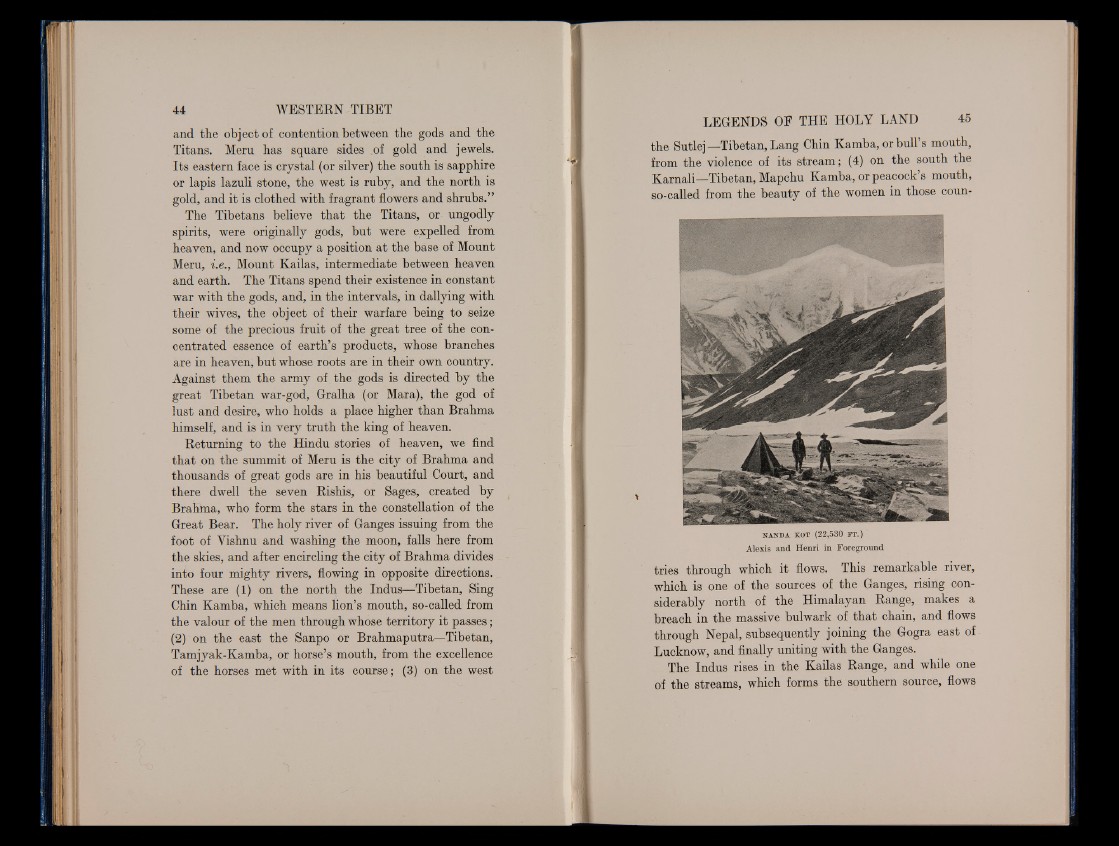
and the object of contention between the gods and the
Titans. Meru has square sides .of gold and jewels.
Its eastern face is crystal (or silver) the south is sapphire
or lapis lazuli stone, the west is ruby, and the north is
gold, and it is clothed with fragrant flowers and shrubs.”
The Tibetans believe that the Titans, or ungodly
spirits, were originally gods, but were expelled from
heaven, and now occupy a position at the base of Mount
Meru, i.e., Mount Kailas, intermediate between heaven
and earth. The Titans spend their existence in constant
war with the gods, and, in the intervals, in dallying with
their wives, the object of their warfare being to seize
some of the precious fruit of the great tree of the concentrated
essence of earth’s products, whose branches
are in heaven, but whose roots are in their own country.
Against them the army of the gods is directed by the
great Tibetan war-god, Gralha (or Mara), the god of
lust and desire, who holds a place higher than Brahma
himself, and is in very truth the king of heaven.
Returning to the Hindu stories of heaven, we find
that on the summit of Meru is the city of Brahma and
thousands of great gods are in his beautiful Court, and
there dwell the seven Rishis, or Sages, created by
Brahma, who form the stars in the constellation of the
Great Bear. The holy river of Ganges issuing from the
foot of Vishnu and washing the moon, falls here from
the skies, and after encircling the city of Brahma divides
into four mighty rivers, flowing in opposite directions.
These are (1) on the north the Indus—Tibetan, Sing
Chin Kamba, which means lion’s mouth, so-called from
the valour of the men through whose territory it passes;
(2) on the east the Sanpo or Brahmaputra—Tibetan,
Tamjyak-Kamba, or horse’s mouth, from the excellence
of the horses met with in its course; (3) on the west
the Sutlej—Tibetan, Lang Chin Kamba, or bull’s mouth,
from the violence of its stream; (4) on the south the
Karnali—Tibetan, Mapchu Kamba, or peacock’s mouth,
so-called from the beauty of the women in those coun-
KAUDA KOT (2 2 ,5 3 0 F T .)
Alexis and Henri in Foreground
tries through which it flows. This remarkable river,
which is one of the sources of the Ganges, rising considerably
north of the Himalayan Range, makes a
breach in the massive bulwark of that chain, and flows
through Nepal, subsequently joining the Gogra east of
Lucknow, and finally uniting with the Ganges.
The Indus rises in the Kailas Range, and while one
of the streams, which forms the southern source, flows